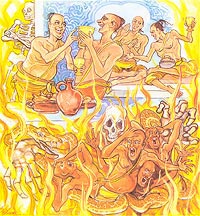20 08 2012 Monday LESSON 682 FREE ONLINE eNālāndā Research and Practice UNIVERSITY
through
http://sarvajan.ambedkar.org
Dhammapada Verse 307 Duccaritaphalapilita Vatthu-Evil Men Get Born In Bad States
To
OUT LOOK, Christopher Queen, Sharmila Rege, S. Anand, Anand Bollimera, Gail Omvedt, Slavoj Žižek, Anand Teltumbde, Harish Wankhede, Arun Kumar, Yogendra Yadav, Alakshyendra, Naveen, Bharat, Kiran, Anwaar, Puneet, Shyamal Barua, Sanjiv Bhandarkar, Somshankar Bose, Vipin, sononemilind, Vinod Mehta, Ramachandra Guha, Jaitley, Inder Malhotra, N. Ram, Swapan Dasgupta, R V Subramanian, Whatever, sandilya, Santosh Gairola, Chira, Raveesh Varma, wayne alfred, Sankar Ramamurthy, Sudheendra Kulkarni, Saba Naqvi, D.L.Narayan,Apoorvanand, Panini Anand, V.N.K.Murti,shaturya
Ambedkar the Awakened One With Awareness had stature as a social actor and the value of his scholarship since he knew the Exposition of Dukkhasacca-துக்கச்சத்தியம் விளக்கிக்காட்டுதல்
And what, bhikkhus, is jāti (birth)? For the various beings in the various classes of beings, jāti, the birth, the descent [into the womb], the arising [in the world], the appearance, the apparition of the khandhas (a mass, a heap, a collection of, ‘all that constitutes/ is comprised under…’ (ex: dukkha-khandha: all that constitutes dukkha).
), the acquisition of the āyatanas (sphere, stretch, extent, reach, sphere of perception). This, bhikkhus, is called jāti.
மற்றும் என்ன, பிக்குகளே, jāti பிறப்பு என்பது? பல்வேறு வகைப்பட்ட உயிர்களுக்கு பல்வேறு வகைப்பட்ட வர்க்கம், jāti பிறப்பு, இந்த பரம்பரை [கருப்பைக்குள்ளே] இந்த khandhas ஒரு திணிவு/நிறை/பொருண்மை/மொத்தை/கட்டி/ ஒரு குவியல்/ஒருங்கு குவி/ ஒரு தொகுப்பு/ தண்டல்/ திரட்டு/கற்பனையுருவ தோற்ற குவியல் எல்லாம் அதை உருவாக்கி உள்ளடக்கமாகக் கொண்டிருக்கிற மனநிறைவு தாராத /இனிமையற்ற /துன்பப்படுகிற வேதனை /ஆழ்துயர்நிலை /உபாதையின் கீழே āyatanas இயற்கைச்சூழல்/பற்றியிழுப்பு/விஸ்தீரணம்/ கிடைக்கப் பெறு/புலனுணர்வின் கோள வடிவத்தை கையகப்படுத்தல், இது, பிக்குளே, jāti பிறப்பு என்பது.
And what, bhikkhus, is the dukkha ariyasacca? Jāti is dukkha, aging
is dukkha (sickness is dukkha) maraṇa is dukkha, sorrow, lamentation,
dukkha, domanassa and distress is dukkha, association with what is
disliked is dukkha, dissociation from what is liked is dukkha, not to
get what one wants is dukkha; in short, the five upādāna·k·khandhas are
dukkha.
மற்றும் என்ன, பிக்குகளே, dukkha ariyasacca துக்க மேதக்க மெய்ம்மை
என்பது?Jāti is dukkha பிறப்பு என்பது துக்கம், மூப்படைதல் என்பது துக்கம்
(நோய்நிலை என்பது துக்கம் )maraṇa மரணம் என்பது துக்கம், மனத்துயரம்,
புலம்பல், துக்கம், domanassa மனதிற்குரிய கவலை சச்சரவு நோய் மற்றும்
இடுக்கண் என்பது துக்கம், எது வெறுப்புடன் கூட்டமைகிரதோ கிடைக்காவிடில் எது
வெறுப்புடன் கூட்டமைகிரதில்லையோ அது துக்கம், ஒருவருக்கு தேவைகள்
கிடைக்காவிடில் அது துக்கம், சுருக்கம்,ஐந்து upādāna·k·khandhas
பற்றாசைகளின் ஒன்று சேர்க்கை என்பவை துக்கம்.
You are all requested to concentrate on such teachings along with your other activities. There are 84,000 types of births and 84,000 solutions in the TIPITAKA. You may write these teachings in different languages. Such an activity will bring peace, welfare and happiness to all living beings.

Verse 307. Evil Men Get Born In Bad States
Many who wear the yellow robe
are unrestrained in evil things,
these evil ones by evil deeds,
in hell do they arise.
Explanation: Many men wearing the yellow robe up to their
necks who have an evil disposition and are unrestrained in thought,
word and deed are reborn in hell on account of their evil deeds.
Dhammapada Verse 307
Duccaritaphalapilita Vatthu
Kasavakantha bahavo
papadhamma asannata
papa papehi kammehi
nirayam te upapajjare.
Verse 307: Many men wearing the yellow robe up to their necks who have an
evil disposition and are unrestrained in thought, word and deed are reborn in
niraya on account of their evil deeds.
The Story of Those Who Suffered for Their Evil Deeds
While residing at the Veluvana monastery, the Buddha uttered Verse (307) of
this book, with reference to some petas.
Once, the Venerable Maha Moggallana was coming down the Gijjhakuta hill with
Thera Lakkhana when he saw some petas. When they were back at the monastery,
Thera Maha Moggallana told Thera Lakkhana, in the presence of the Buddha, that
he had seen a peta who was just a skeleton. Then he added that he had also seen
five bhikkhus with their body burning in flames. On hearing the statement about
those bhikkhus, the Buddha said, “During the time of Kassapa Buddha,
those bhikkhus had done much evil. For those evil deeds they had suffered in
niraya and now they are serving out the remaining term of suffering as
petas.”
Then the Buddha spoke in verse as follows:
| Verse 307: Many men wearing the yellow robe up to their necks who have an evil disposition and are unrestrained in thought, word and deed are reborn in niraya on account of their evil deeds. |